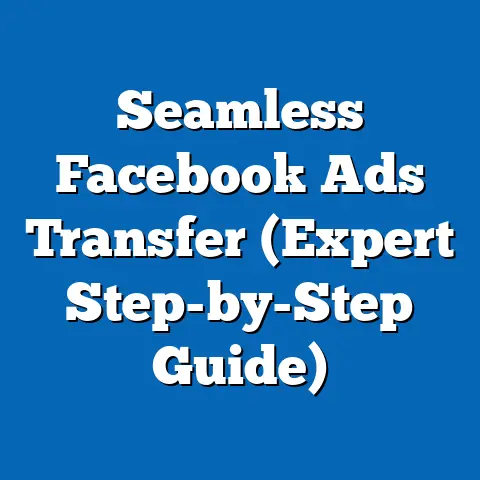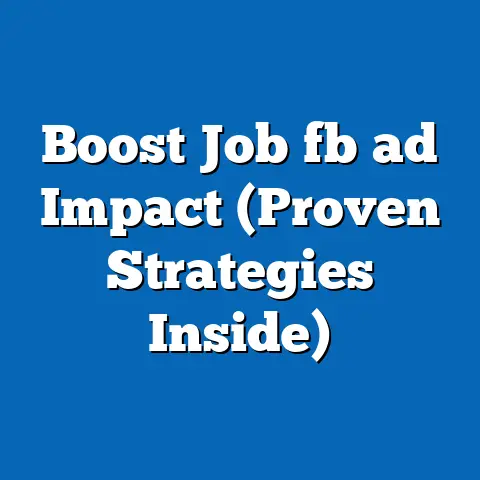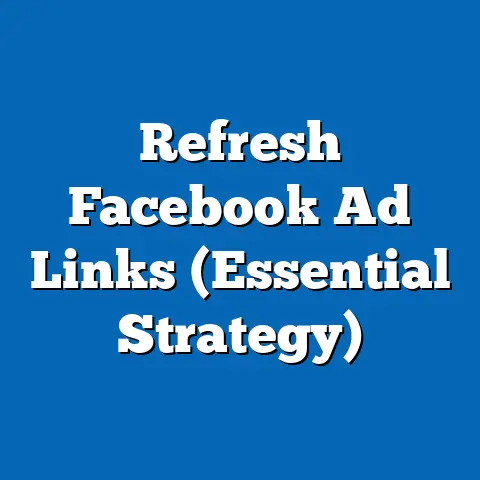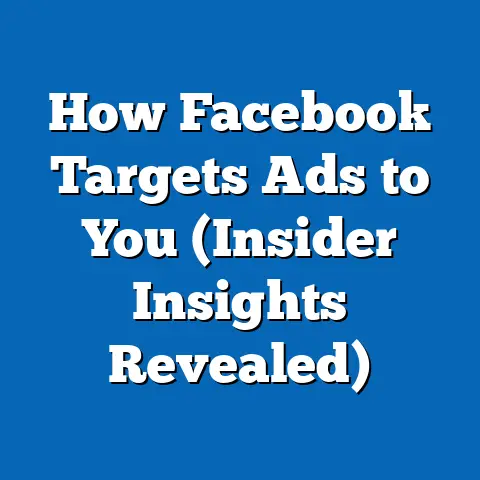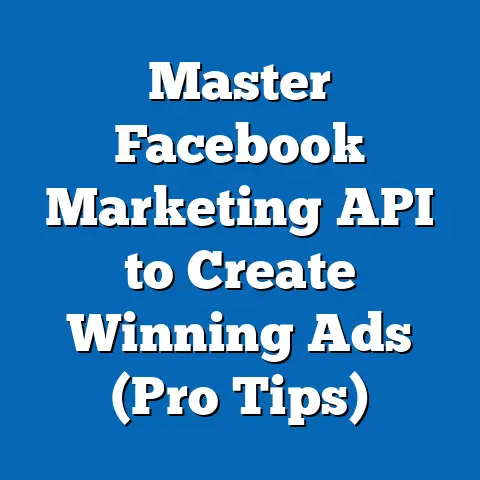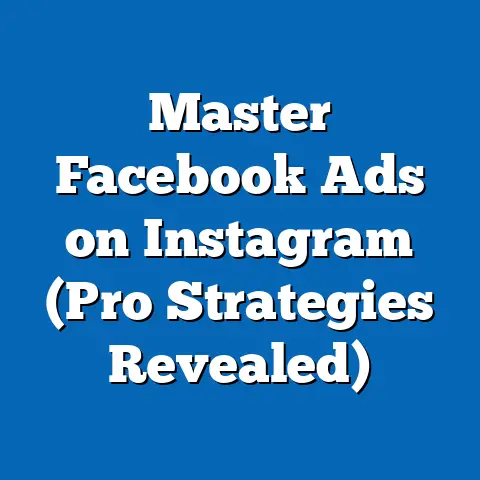Boost Mortgage Leads with Facebook Ads (Proven Strategies)
Have you ever wondered how some mortgage professionals seem to effortlessly attract high-quality leads while others struggle to fill their pipelines? In an increasingly digital world, the answer often lies in leveraging the unparalleled reach and precision of platforms like Facebook Ads. As the mortgage industry becomes more competitive, understanding how to harness social media advertising can be the difference between stagnation and exponential growth.
Defining Characteristics of Successful Facebook Ads for Mortgage Leads
Facebook Ads offer a unique opportunity for mortgage professionals due to their advanced targeting capabilities, cost-effectiveness, and vast user base of over 2.9 billion monthly active users as of 2023 (Statista, 2023). Unlike traditional advertising, which often casts a wide net with limited measurable impact, Facebook Ads allow for hyper-specific audience segmentation based on demographics, interests, behaviors, and even life events like moving or getting married. This precision ensures that mortgage ads reach individuals who are most likely to be in the market for a home loan.
Another defining characteristic is the platform’s emphasis on visual storytelling. High-quality images, engaging videos, and carousel ads showcasing properties or client testimonials can capture attention more effectively than text-heavy formats. Additionally, the ability to retarget website visitors or past leads through custom audiences enhances conversion rates by keeping your brand top-of-mind.
Success on this platform also hinges on compliance with advertising regulations, particularly in the financial sector. Facebook’s Special Ad Categories policy, introduced in 2019, restricts targeting options for housing, employment, and credit ads to prevent discriminatory practices. Mortgage advertisers must navigate these rules carefully, focusing on broad interest targeting while still achieving relevance.
Historical Context: The Evolution of Mortgage Marketing and Digital Advertising
To fully appreciate the power of Facebook Ads for mortgage leads, it’s essential to understand the historical context of mortgage marketing. In the pre-digital era, mortgage brokers relied heavily on face-to-face interactions, direct mail campaigns, and print advertisements in local newspapers. These methods, while effective for building trust in small communities, were limited in scale and difficult to measure.
The advent of the internet in the late 1990s and early 2000s marked a turning point, as mortgage companies began establishing online presences through websites and email marketing. Search engine advertising, particularly Google Ads, emerged as a dominant force in the early 2000s, allowing brokers to capture leads actively searching for mortgage information. However, this “pull” marketing approach often missed potential clients who weren’t yet in the research phase.
Facebook, launched in 2004, revolutionized digital advertising with its social networking model and data-driven ad platform introduced in 2007. By the 2010s, mortgage professionals began recognizing the value of “push” marketing on social media—reaching potential clients before they even started searching. This shift coincided with broader societal trends, including the rise of mobile internet usage and changing consumer expectations for personalized, on-demand services.
The 2008 financial crisis also played a pivotal role in shaping mortgage marketing. With tightened lending standards and a skeptical public, trust became a central theme in advertising. Social proof, such as client reviews and community engagement on platforms like Facebook, became critical for rebuilding credibility—a trend that persists today.
Societal Implications: How Digital Advertising Shapes Homeownership and Financial Behavior
The rise of Facebook Ads in the mortgage industry reflects broader societal shifts in how people make financial decisions. Today’s consumers, particularly younger generations like Millennials and Gen Z, are digital natives who turn to social media for inspiration, recommendations, and education before committing to major purchases like a home. A 2022 study by the National Association of Realtors found that 51% of homebuyers under 40 used social media as part of their home search process, highlighting the growing influence of platforms like Facebook.
This trend has democratized access to mortgage information, allowing smaller brokers and independent professionals to compete with large banks by reaching niche audiences affordably. However, it also raises concerns about data privacy and the ethical use of targeting. With Facebook’s history of data scandals, such as the 2018 Cambridge Analytica incident, consumers are increasingly wary of how their personal information is used in advertising.
Moreover, the shift to digital advertising has implications for financial literacy. While well-crafted ads can educate potential borrowers about loan options, poorly designed or misleading campaigns risk perpetuating misinformation. Regulatory bodies like the Consumer Financial Protection Bureau (CFPB) have emphasized the need for transparency in mortgage advertising, a challenge that professionals must address to maintain trust.
Proven Strategies for Boosting Mortgage Leads with Facebook Ads
Having established the context and significance of Facebook Ads in the mortgage industry, let’s explore actionable strategies to maximize lead generation. These tactics are grounded in data, case studies, and best practices from top-performing campaigns.
1. Define Your Target Audience with Precision
While Special Ad Categories limit certain targeting options, you can still refine your audience by focusing on geographic location, interests (e.g., real estate, home improvement), and behaviors (e.g., recent engagement with mortgage-related content). For example, targeting users in specific ZIP codes near upcoming open houses or new developments can yield high-intent leads. Additionally, creating lookalike audiences based on past clients or website visitors can expand your reach to similar prospects.
Consider segmenting audiences by life stage—first-time homebuyers, move-up buyers, or refinancers—and tailoring messaging to their unique pain points. A 2021 report by HubSpot found that segmented ad campaigns on social media platforms achieve a 76% higher click-through rate (CTR) compared to non-segmented ones. Testing different audience combinations through A/B testing will help identify the most responsive groups.
2. Craft Compelling and Compliant Ad Creative
Your ad’s visual and textual elements are critical for standing out in a crowded newsfeed. Use high-resolution images of homes or happy families to evoke emotional connections, paired with concise headlines like “Ready to Own Your Dream Home?” or “Low Rates—Apply Today!” Video ads, which can showcase virtual tours or explain loan processes, often perform better, with Facebook reporting a 20-30% higher engagement rate for video content in 2022.
Compliance is non-negotiable. Include clear disclaimers about loan terms (e.g., “Subject to credit approval”) and avoid making guarantees about approval or rates, as mandated by the Truth in Lending Act (TILA). Partnering with a compliance officer or legal expert ensures your ads meet federal and platform-specific guidelines, reducing the risk of penalties or account suspension.
3. Leverage Lead Generation Forms for Instant Capture
Facebook’s Lead Ads format is a game-changer for mortgage professionals, allowing users to submit their contact information directly within the platform without navigating to an external site. These forms can be pre-filled with user data (like name and email), reducing friction and boosting completion rates. A 2020 case study by Facebook revealed that Lead Ads reduced cost-per-lead by 20% for a mortgage broker compared to traditional link ads.
Customize form fields to gather essential information—such as income range or desired loan amount—while keeping questions minimal to avoid deterring users. Follow up promptly with automated email or SMS campaigns to nurture these leads, as speed-to-contact is a proven factor in conversion rates.
4. Utilize Retargeting to Re-Engage Warm Leads
Not all prospects convert on the first interaction, but retargeting can bring them back. By installing the Facebook Pixel on your website, you can track visitors and serve them reminder ads tailored to their behavior—such as viewing a specific loan product page. Retargeting campaigns often achieve a 2-3x higher ROI compared to cold audience ads, according to a 2021 study by AdRoll.
For instance, if a user visited your refinance calculator but didn’t submit a form, show them an ad highlighting current low rates with a clear call-to-action (CTA) like “Finish Your Application Now.” Combining retargeting with dynamic ads, which automatically display relevant content based on user activity, can further personalize the experience.
5. Optimize for Mobile and Local Engagement
With over 98% of Facebook users accessing the platform via mobile devices (Statista, 2023), ensuring your ads and landing pages are mobile-friendly is essential. Use vertical video formats (9:16 aspect ratio) for Stories and Reels, and ensure landing pages load quickly with easy-to-tap buttons. Google’s research indicates that 53% of mobile users abandon sites that take longer than 3 seconds to load, a statistic that directly impacts lead conversion.
Local targeting adds another layer of relevance. Promote community-specific offers or events, such as “Free Homebuyer Workshop in [City Name],” to build trust and attract nearby prospects. Engaging with local Facebook Groups or running ads tied to regional housing trends can also position you as a trusted advisor in the area.
6. Monitor Metrics and Iterate Continuously
Data is your best friend when optimizing Facebook Ads. Track key performance indicators (KPIs) like CTR, cost-per-lead (CPL), conversion rate, and return on ad spend (ROAS) using Facebook Ads Manager. For context, the average CPL for mortgage ads ranges from $20 to $50, though top performers often achieve $10-15 through rigorous testing (WordStream, 2023).
Experiment with different ad formats, copy variations, and audience segments to identify what resonates. For example, if a video ad underperforms, test a static image with a stronger CTA. Regularly reviewing analytics ensures your budget is allocated to the highest-performing campaigns, maximizing efficiency over time.
Comparing Generational Responses to Mortgage Ads on Facebook
Generational differences play a significant role in how audiences respond to mortgage ads on Facebook, reflecting varying levels of tech-savviness, financial priorities, and trust in digital platforms. Millennials (born 1981-1996), who represent a large portion of first-time homebuyers, are highly active on social media and responsive to visually engaging, educational content. A 2022 Pew Research study found that 70% of Millennials use Facebook regularly, making it a prime channel for reaching this group with ads about down payment assistance or FHA loans.
Gen X (born 1965-1980), often in the move-up or refinance market, values credibility and detailed information. They may respond better to ads featuring client testimonials or interest rate comparisons, though their engagement on Facebook is slightly lower at 60% (Pew Research, 2022). Baby Boomers (born 1946-1964), while less active on social media (around 40% usage), can still be reached with ads focused on reverse mortgages or retirement planning, often requiring simpler messaging due to varying comfort with technology.
These differences underscore the importance of tailoring ad creative and messaging to generational preferences while avoiding stereotypes. Within each group, individual behaviors vary widely based on socioeconomic status, location, and personal circumstances, necessitating a data-driven approach to audience segmentation.
Technological, Economic, and Cultural Factors Influencing Campaign Success
Technological advancements underpin the effectiveness of Facebook Ads for mortgage leads. The platform’s machine learning algorithms, which optimize ad delivery based on user engagement, enable even small-budget campaigns to achieve significant reach. Innovations like augmented reality (AR) ads, where users can visualize home interiors, are emerging as tools to captivate younger audiences.
Economically, fluctuating interest rates and housing market conditions directly impact ad performance. During periods of low rates, as seen in 2020-2021, mortgage ads often see higher engagement due to increased demand for refinancing. Conversely, rising rates in 2022-2023 have shifted focus to first-time buyer programs and affordability solutions, requiring advertisers to adapt messaging accordingly.
Culturally, the growing emphasis on diversity and inclusion influences how mortgage ads are perceived. Campaigns that reflect a range of family structures, ethnicities, and lifestyles resonate more with today’s socially conscious consumers. Additionally, the cultural shift toward remote work has spurred interest in suburban and rural properties, a trend advertisers can tap into by highlighting loans for non-traditional locations.
Nuances and Diversity Within Target Audiences
While generational and demographic targeting provides a starting point, it’s critical to recognize the diversity within any audience segment. For instance, not all Millennials are first-time buyers; many are now in their late 30s or early 40s, seeking larger homes for growing families. Similarly, urban versus rural prospects may have vastly different priorities, with the former valuing proximity to amenities and the latter focusing on land size or affordability.
Income levels, credit scores, and cultural backgrounds further complicate targeting. A one-size-fits-all ad risks alienating potential leads, so mortgage professionals must use dynamic creative optimization (DCO) to serve personalized content. Qualitative feedback from past clients, combined with quantitative data from ad analytics, can reveal these nuances and inform more inclusive strategies.
Implications for the Mortgage Industry and Beyond
The integration of Facebook Ads into mortgage lead generation has far-reaching implications for the industry. On a practical level, it levels the playing field, enabling independent brokers to compete with large institutions through targeted, cost-effective campaigns. This democratization fosters innovation, as smaller players experiment with creative formats and niche markets.
In the workplace, the shift to digital marketing demands new skill sets, from data analysis to content creation. Mortgage firms may need to invest in training or hire specialists to manage ad campaigns, reflecting a broader trend of digital transformation across industries. Collaboration between marketing and compliance teams is also essential to balance creativity with regulatory adherence.
Societally, the reliance on social media for financial decisions underscores the need for consumer education. Mortgage professionals have an opportunity—and responsibility—to provide value through ads that inform rather than merely sell. Partnerships with housing nonprofits or government agencies could amplify this impact, ensuring underserved communities gain access to homeownership resources.
Forward-Looking Insights: The Future of Mortgage Advertising on Facebook
As we look ahead, the landscape of Facebook Ads for mortgage leads is poised for further evolution. Emerging technologies like artificial intelligence (AI) will enhance ad personalization, predicting user needs with greater accuracy. However, privacy regulations, such as the General Data Protection Regulation (GDPR) and California Consumer Privacy Act (CCPA), may impose stricter limits on data usage, challenging advertisers to find new ways to target effectively.
The rise of competing platforms, like TikTok and Instagram (also under Meta’s umbrella), could fragment audiences, requiring a multi-channel approach. Yet, Facebook’s mature user base and robust ad tools are likely to maintain its dominance in the mortgage space for the foreseeable future. Staying agile—through continuous learning and adaptation—will be key to navigating these uncertainties.
Moreover, as housing affordability remains a pressing issue, mortgage ads may increasingly focus on innovative financing solutions, such as shared equity programs or government-backed loans. Advertisers who position themselves as problem-solvers, rather than just lenders, will likely build stronger, longer-lasting relationships with clients.
Conclusion
Boosting mortgage leads with Facebook Ads is not just a marketing tactic; it’s a strategic imperative in a digital-first world. By understanding the platform’s defining characteristics, historical context, and societal implications, mortgage professionals can craft campaigns that resonate with diverse audiences while navigating compliance challenges. The proven strategies outlined—from precise targeting to compelling creative—offer a roadmap for success, grounded in data and real-world application.
As generational, technological, and economic dynamics continue to shift, so too must advertising approaches. The future holds both opportunities and uncertainties, but one thing is clear: those who embrace innovation, prioritize consumer trust, and adapt to change will lead the way in transforming how homeownership dreams are realized. Are you ready to harness the power of Facebook Ads and redefine your mortgage business?

